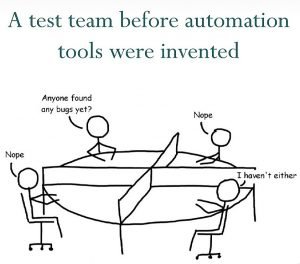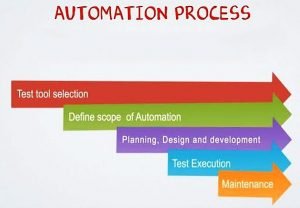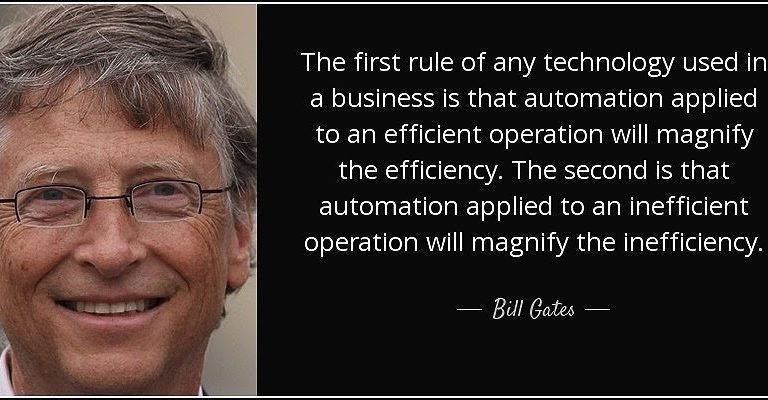Performing automation is easy only if you manage to keep the undertaking hassle-free. Automating a test doesn’t have to be perplexing. You just need to get the proper hang of it and keep your modus operandi uncomplicated. When automation loses its simplicity, it does more harm than good. Not so surprisingly, this is the sole reason behind the failure of numerous automation projects. People make it harder than it looks, giving rise to a ripple effect of mismanagement. Programmers adopt automation with the hopes of high-speed innovative testing but end up turning everything into a total disaster. Some even start foul-mouthing test automation when it doesn’t yield their dream outcome. While in reality, the fault lies in their own ways. So moral of the story: analyze your own workflow. Don’t blame automation if you’re the one to mess it up.
Automation presents the perks of an upswing in proficiency, durability and capacity. It clarifies the execution of boring, tricky tasks. With cutbacks in cost, smoother & organized progression of tests that can be tracked in real-time, and freedom from mind-numbing recurrent processes, automation has emerged as a business regulation practice.

Tools are the soul of automation. They’re the very definition of it. When machines assess your code, that’s called automation. Test automation got tools tactfully crafted for and designated to explore specific zones of the software. These reusable & robust tools swiftly scan your program for bugs, catching them early on. Schedule their rendition and sit back while your code goes through the quality check.
Heaps of code, loads of devices and eyeing the operation of the sea of code on each one the devices is practically unachievable by any human, forget it being uniform & accurate. But with tools, all highs & lows of the program like databases, UI, web services etc. are inspected to see whether they’re with your requirements. Hence test coverage: upgraded. No bug is left behind, as tools present a detailed bug report for each & every one of them eliminating all kinds of human errors. Now you can reduce your team size and assign the extra brains you got to other projects.

Therefore, automation:
- Is faster, better, superior.
- Is time-saver and economical.
- Is reliable & consistent.
- Has a wider test coverage.
- Test scripts can be used as frequently as you want and as many times as you want.
- Guarantees early product launch.
As said in the last point above, automation does shorten the release cycle. But although it’s cost-effective, you gotta pay the price in the form of your insightful planning. Without a wise & foreseeable plan of action, automating will get backfired scrapping all the above-mentioned merits.
The three main pillars of successful automation are tools, team and infrastructure. As automation is tool-driven, getting your hands on the tool(s) which align perfectly with your project vision is even more crucial than your code. Right tools will dig out the abnormalities in your code; but if the tool doesn’t fit, you’re heading for a dead loss. Secondly, we need a troupe of testers, qualified & well-versed in automation.
Then arrange the framework and devote time & efforts to develop tests on it. Building test scripts is like a mini-project involving writing, designing & authentication of the scripts before deployment.
It doesn’t end there. Automation is a continuous process. A major effort still remains just when you think you’re done. That is maintenance of test cases so that they can be reused.

So what’s the mantra to make your test automation project thrive? Even if you studied automation, have the right tools, squad and infrastructure in hand, the real challenge comes when you put your knowledge to practical use. To aid your journey in this field, we present to you a catalogue incorporating the very essential dos & don’ts.
Simplicity is the best policy
As mentioned in the intro too, simplifying your test automation procedure is the best practice. To be honest, that should be the only practice. It might come as a surprise but when it comes to designing a test suite, the complex is easy. A test case becomes complex when you employ the features of your tools in as many ways as possible. But the story gets fiddly when you’ve to maintain this test case for reuse. A simple test case takes brain & sweat to develop but it is simple to manage, share and understand and is more reliable in the long run. Simplicity eliminates the unnecessary hustle. Just take these steps for a ‘simple’ test case:
- Pick out what to automate.
- Identify the components playing the major part in acquiring the test results.
- Decide the perfect test automation layout.
- Discover the best approach for test environment management and test data.
- Gather code reviews to improve the test quality.
- Study your test’s capabilities.
- Keep track of the expiry date of your tests.
Never automate from the very first day
Every project has its own tempo. Even the project’s features can grow or alter at any time during its course. Take time to carefully analyze all of this before jump-starting your test automation process. Remember, slow & steady wins the race.
Right team, right tool: The Vitals
Your crew should be composed of automation experts and headed by an Automation Architect. Your manual testers won’t be able to handle the full-time process of automation along with their own tasks. Therefore, it’s best to appoint a few automation testers (depending on your project size) leads by an expert Automation Architect and leave the rest to them.
Coming to the tool, it must be chosen cautiously. Explore the languages, technologies, supporting environment, external controls etc. associated with your project. Then select the tool that complements all these traits. In addition, your team’s forte must be kept in mind too. Use a tool your team is familiar with. This will save you an ample amount of time while exhibiting optimum results for the impending project.
LambdaTest is an eminent tool that can be your workmate in your automation endeavor. Its online Selenium Grid Cloud with 2000+ Desktop & Mobile Browsers will take your test automation game to the next level. It has an impressive collection of many popular languages and also allows efficient Parallel and Geolocation testing. It also offers the provision of codeless automation testing to lessen manual efforts.
Don’t have impractical presumptions
Finalizing the tool is truly the most important venture, yet it’s not enough. You need to hand over this tool to the master testers who’ll study the bugs detected and find suitable & ingenious solutions to tackle them. Even if you have the perfect tool, you still can’t automate anything and everything.

Document false failures
Automation practically means having a group of robotic helpers that carry out your test cases. However, as there’s no human touch involved it gives rise to false fails. There are two types of false failures: false positive and false negative. When a test case fails yet there’s no actual error in the software under test and the functioning is flawless, this event is called false positive. And a false negative occurs when the bugs go undetected and the test case deems the code to be faultless. Of these two, the false negative is much more dangerous & damaging as it leaves the bug in the software, endangering the software quality and in turn, customer trust. So it is advisable to have better test planning and have a balanced alliance between manual and automated testing.
Never undervalue a good manual test
Automation is an extension of manual testing. There’s no manual vs automation. It is helpful & profitable to write manual test cases containing all the prerequisites & test data, complete a list of all the steps involved and even the predicted result of each step. Automation flourishes only when you get the fundamentals correct. Make every test case self-standing and interpret their flow by manually executing them. A premature brainstorming session among the manual & automation testers can pinpoint the majority of bugs in the test development phase itself.
Widen your test case orbit
As mentioned above, a well written manual test case plays a huge role in the success of test automation. Still, a manual test case shouldn’t be run as it is, no matter how elaborately scripted it is. Document all the contemplated end results and possible layouts and use them as the data source. Distinguish tasks that are easier with automation like Load Testing, Repetitive tests under different circumstances, Performance testing, high precision tests, Memory leaks etc.
Don’t automate GUI
Automating a GUI test is quite stressful. So the best advice would be to avoid them if you can. This simplifies your testing procedure and cuts short its duration.
Be consistent
Developing an automation framework is a software project in itself. Your automated test cases and the infrastructure will scrutinize your project to ensure superior quality. So the fact is indispensable that your test automation layout must be the maven of bug reporting, code anatomization, etc. Automation requires constant devotion like any other software project.
Never delay updates
Although automation test cases are reusable, they are so only when they’re maintained properly. They’ve to be revamped from time to time to make them compatible with the changing world. Procrastinating the updates automation regression suites is going to diminish the efficacy of the regression test.
Fractionate your test cases
Divide your test suite into numerous independent test cases making it easier to administer them. Even if one test fails to perform, others would be unaffected and keep on functioning.
Don’t automate it all
Automation exists to aid in carrying out recurring testing tasks steering the path clear for other work areas. However, not everything is worth automating. Some jobs are better done manually. Like in the case of a rarely used feature, it might be more penny-wise to manually test it than to invest in an automated test that would be occasionally used.
Automation isn’t here to phase out the manual ventures. Rather a balanced blend of manual & automation helps enrich the whole testing procedure. Amplify your automation skills by taking these suggestions into account. Get tools like the LambdaTest that’ll take your prowess one more notch higher. Alongside live and responsive testing, you get to other exciting options of Screenshot testing, Integrated testing, Geolocation testing, and so much more. This tool can totally refurbish your whole automation aptitude.





